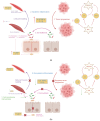Modulating the Gut-Muscle Axis: Increasing SCFA-Producing Gut Microbiota Commensals and Decreasing Endotoxin Production to Mitigate Cancer Cachexia
- PMID: 40572244
- PMCID: PMC12196049
- DOI: 10.3390/microorganisms13061356
Modulating the Gut-Muscle Axis: Increasing SCFA-Producing Gut Microbiota Commensals and Decreasing Endotoxin Production to Mitigate Cancer Cachexia
Abstract
Cancer cachexia is a multi-organ and multifactorial syndrome characterized by muscle wasting (with or without adipose tissue loss) and systemic inflammation in patients with advanced malignancies. Gut microbiota dysbiosis, particularly the depletion of short-chain fatty acid (SCFA)-producing bacteria, may contribute to the progression of cancer cachexia. Studies in both murine models and humans consistently associate cachexia with a decline in SCFA-producing gut microbiota commensals and an overgrowth of pro-inflammatory pathobionts. These microbial imbalances may lead to reduced levels of SCFAs and branched-chain amino acids (BCAAs) and alter the normal bile acid profile. BCAAs and the maintenance of a normal bile acid profile are associated with muscle synthesis and decreased breakdown. While SCFAs (acetate, propionate, and butyrate), contribute to intestinal barrier integrity and immune regulation. SCFA depletion may increase gut permeability, allowing bacterial endotoxins, such as lipopolysaccharide (LPS), to enter the bloodstream. This may lead to chronic inflammation, muscle catabolism, and impairment of anabolic pathways. Interventions targeting gut microbiota in preclinical models have mitigated inflammation and muscle loss. While clinical data are limited, it suggests an improvement in immune functions and better tolerance to anticancer therapies. Current evidence is predominantly derived from cross-sectional studies suggesting associations without causality. Thus, future longitudinal studies are needed to identify biomarkers and optimize personalized therapy.
Keywords: bile acids; branched chain amino acids (BCAAs); cancer cachexia; dysbiosis; fecal microbiota transplantation; gut microbiota; inflammation; intestinal barrier integrity; microbiome-based therapies; prebiotics; probiotics; short-chain fatty acids (SCFAs); synbiotics.
Conflict of interest statement
M.N. is a founder and scientific advisory board member of Caelus Pharmaceuticals and Advanced Microbiome Interventions, the Netherlands. He is also on the board of directors of Diabeter Netherlands BV. The Amsterdam UMC has patented the use of donor FMT in cancer cachexia. However, all the other COIs are not directly related to the content of the current manuscript.
Figures


References
Publication types
LinkOut - more resources
Full Text Sources

